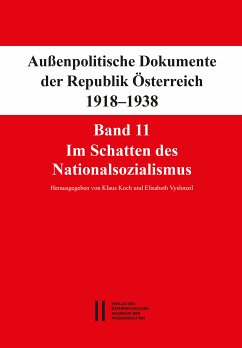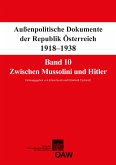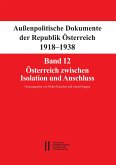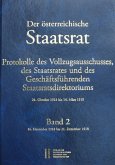Nach dem deutsch-österreichischen Juliabkommen 1936 und der damit verbundenen Aufhebung der Tausend-Mark-Sperre verbesserte sich Österreichs Wirtschaftslage deutlich. Die im Oktober 1936 gebildete Achse Berlin - Rom ließ erkennen, dass nun Mussolini durch seine Annäherung an Hitler als Garant für die Unabhängigkeit Österreichs ausfallen würde. Als Schuschnigg und der neue Staatssekretär Guido Schmidt im April 1937 von Mussolini und Außenminister Ciano in Venedig empfangen wurden, machte Mussolini klar, dass eine Ordnung des Donauraumes ohne Deutschland nicht in Frage komme. Und auch seitens der Westmächte konnte seit Schmidts London-Besuch 1937 keine Garantie für Österreichs Unabhängigkeit mehr erwartet werden. Andererseits erließ der deutsche Reichskriegsminister Werner von Blomberg am 24. Juni eine "Weisung für die einheitliche Kriegsvorbereitung der Wehrmacht", in der unter dem Titel "Sonderfall Otto" der Einmarsch deutscher Truppen in Österreich für den Fall einer Restauration der Habsburger vorgesehen wurde. Im Rahmen des Volkspolitischen Referats der Vaterländischen Front wurden ab Februar 1937 illegale Nationalsozialisten in die Regierungsarbeit einbezogen. Schon bald war der Mitgliederstand der illegalen österreichischen NSDAP auf 75.572 gewachsen. Auch der privat angelegte Besuch Staatsekretär Schmidts beim jovial gelaunten Preußischen Ministerpräsidenten Hermann Göring auf Carinhall zeigte die immer tiefer greifende Annäherung Deutschlands an Österreich - der "Anschluss" war nur noch eine Frage der Zeit.
Dieser Download kann aus rechtlichen Gründen nur mit Rechnungsadresse in A, B, BG, CY, CZ, D, DK, EW, E, FIN, F, GR, HR, H, IRL, I, LT, L, LR, M, NL, PL, P, R, S, SLO, SK ausgeliefert werden.









